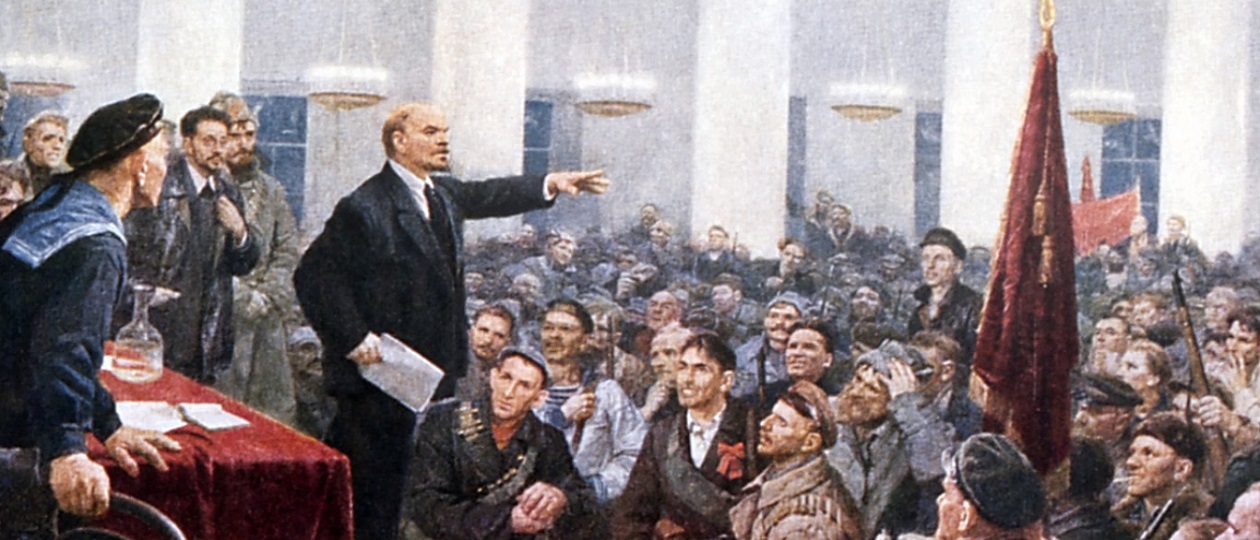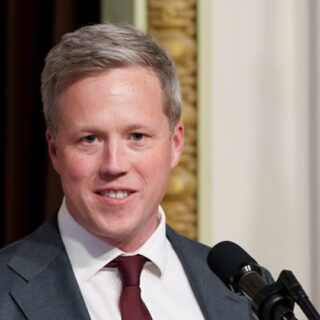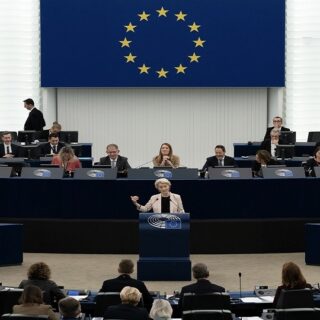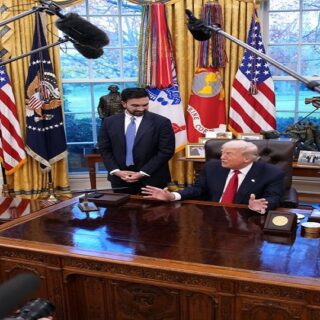
From Multi-Party State to One-Party State: the disintegration and collapse of non-Bolshevik parties and movements in the Russian Revolution.
The former Russian Empire was the most multi-party country in Europe. However, by the early 1920s, the Soviet Union, its successor state, had become Europe’s biggest one-party state. The history of how the Bolsheviks or Communists crushed dozens of non-Bolshevik parties and movements is still one of the least studied aspects of the history of the Russian Revolution of 1917-1922.
Our knowledge about Russia’s political parties has been shaped by decades of research and writing. A major accomplishment of pre-1917 historiography was the publication between 1909-1914 of the four-volume “The movement of society in Russia at the beginning of the XXth century” (Общественное движение в России в начале ХХ века). [1] The compilers of this work were mostly Mensheviks, but this work is an exhaustive investigation showing the different stages of the origins and developments of all political parties and movements.
Only since the collapse of the Soviet Union in 1991 and the opening of archives, have historians been able to investigate the history of non-Bolshevik political parties in Russia before, during, and after the Revolution. Writing about non-Bolshevik parties was a highly controversial topic in the Soviet Union. In the 1920s, Soviet researchers published many collections of documents and polemical works about non-Bolshevik parties. However, from the 1930s to mid-1950s, study of the Bolsheviks’ rival parties was banned under the rule of Joseph Stalin.
Beginning in the 1960s, Soviet historians were allowed to write about non-Bolshevik parties. However, they worked under tight ideological constraints and historians were always expected to show the inevitably logical victory (закономерная победа) of the Bolsheviks in 1917 and the inevitably logical defeat (закономерное поражение) of their political opponents.
In fairness, Soviet historians introduced many valuable primary sources into academic circulation. [2, 96-97] This allowed foreign historians to quote these documents in their works. Several collective monographs about all parties were published. [3] However, authors always described non-Bolshevik parties as non-proletarian or bourgeois or petty-bourgeois parties that were inevitably doomed to defeat because they had been fatally flawed from their origins.
After 1991, post-Soviet scholars published collections of monographs and monographs on many parties, especially on reactionary, conservative, liberal, and other socialist parties. A major accomplishment of post-Soviet historiography was the publication in 1996 of an encyclopedia of political parties. [4]
Members of the post-revolution (White) emigration wrote memoirs and histories about their former parties and movements. Some former parties built up substantial archives in exile. Foreign historians faced major challenges in writing about non-Bolshevik parties because they did not have access to Soviet archives. Use of émigré archives and sources could only go so far. Soviet publications were written under severe ideological constraints, and foreign historians had to critically analyze Soviet sources.
Somewhat ironically, the Soviet emphasis upon the victory of the Bolsheviks and the defeat of their opponents influenced how foreign historians interpreted the Russian Revolution. History too often emphasizes the winners in revolutions and wars. Too many historians drew the conclusion that the Bolsheviks’ political opponents somehow deserved defeat and that these parties had fatal flaws from the beginning of their existence.
Despite the huge advances in post-Soviet and foreign historiography since 1991, study of political parties in the Revolution of 1917-1922 remains uneven. Historians generally focus on only four parties—the Bolsheviks, Mensheviks, Socialists-Revolutionaries (SRs), and liberal Constitutional Democrats (Kadets). Russia had a very diverse range of political parties. According to post-Soviet historian V. V. Kriven’kii, nearly 300 political parties existed in Russia from 1882 to 1925.
Historians usually divide parties into two categories. Empire-wide (общеимперские) or all-Russian (общероссийские) drew their members from the entire empire. These parties usually included the Kadets, Octobrists (Union of October 17, a liberal-conservative party), the Mensheviks, Bolsheviks, SRs, People’s Socialists, SR Maximalists (both split from the SRs in 1906), and the far-right Union of the Russian People (the leading Black Hundreds organization).
The other major category included national (национальные) parties of the non-Russian ethnic minorities that sought autonomy or independence.
Kriven’kii gave the following statistics for the number of parties in Russia. By 1905, there were 4 Empire-wide and 47 national parties. By the February Revolution of 1917, there were 45 Empire-wide and 113 national parties. Between the February and October Revolutions, 8 Empire-wide and 46 national parties were organized. From the end of 1917 until 1925, another 7 Empire-wide and 76-79 national (mostly socialist) parties were formed. Kriven’kii suggested that from 1882-1925, Russia had 60 Empire-wide and 228-231 national parties. [5, 123-130]
These calculations do not include numerous organizations and groups of anarchists of all tendencies. Anarchists did not organize political parties, partly because they regarded parties as part of the political system that they sought to destroy. Nor do the tabulations include marginal groups, on the right and left end of the spectrum, that had no party affiliation.
Russia also had regional parties and movements both in Russian and ethnically-mixed areas. Regionalism was particularly strong in Siberia, and there were regional parties, especially in the western borderlands of the empire. There were also confessional parties, representing different Christian denominations and other religions. There were even Cossack parties and movements.
However, political parties and movements in the Revolution of 1917-1922 inherited many features of parties in pre-revolutionary Russia. The word party comes from the Latin word partis—a part. So what is a political party? The authors of the post-Soviet encyclopedia defined a party as “an organization of a political character that expresses the interests of a certain class or social stratum. This organization unites its most active representatives in the struggle for the winning of political power. [4, 5].
However, Russia’s political parties and movements represented only one stratum of the population—the intelligentsia, the most politically active members of educated society. Soviet historian L. M. Spirin recognized that the intelligentsia organized parties for different classes and he divided political parties into four categories—noble, bourgeois, petty-bourgeois, and proletarian (i.e. Bolsheviks). According to their relationship with the government, parties belonged to three different political camps—government, liberal-oppositional, and revolutionary democratic. [3, 4, 8]
But the encyclopedia authors noted “there are not and cannot be purely class parties, even if these parties proclaim that they represent the interests of a certain class or social stratum.
The characteristic feature of the Russian multi-party system was that its creator and main actor was the intelligentsia. Consequently, both Empire-wide and national parties can be considered organizations of an intelligentsia type. All parties used ideological models of the transformation of society, and these models influenced party programs, organizational structures, and tactics. ” [4, 8]
Because political parties and movements in Russia were intelligentsia movements, their behavior and activity in 1917 between the February and October Revolutions showed contradictory trends.
Political parties and movements in Russia were never rigidly tight organizations. They tended to be amorphous groupings with members shifting back and forth between groups; in fact, many oppositional and revolutionary groups were made up of people of varied ideological tendencies.
The myth of monolithic and ideologically pure parties with rigid boundaries was created by Soviet historians who applied the myth to the Bolshevik Party under Vladimir Lenin and, then, in varying degrees to all other parties and movements. Lenin may have wanted a monolithic party, but many of his followers disagreed and very few could ever foresee the Bolshevik Party becoming the only party in the country.
Much of the reason for the loose party structures was the pre-1917 situation. Political movements in the 1860s and 1870s were based circles, while the conspiratorial structure of the People’s Will was dominant from 1879 to 1894. After the 1905 revolution, reactionary and conservative parties were legal; liberal parties, including the Kadets, were semi-legal; socialist parties and nearly all regionalist and ethnic minority parties were illegal. Party affiliations in Russia were fluid, while they were more rigid among the émigrés, especially since party leaders lived abroad. This dichotomy created tensions between socialist party leaders like Lenin who were invariably émigrés and the rank-and-file members in the Russian Empire.
Socialists in Russia could not afford the luxury of spending time on doctrinal debates and ensuring ideological purity. American historian Michael Melancon has suggested that the degree of unity among leftists in pre-1917 Russia was much higher than most have suspected. As he noted:
<<Russian socialists often used the slogan «vroz’ idti, vmeste bit’», which signified that socialists should maintain separate party identities (march apart), but, if revolution approached, join together to deliver the coup de grace. Even in ordinary times, in tsarist Russia «marching apart» was a luxury revolutionaries could rarely afford. Of course, various parties and factions did not completely sacrifice their independence, but at all levels they informally coordinated activities and, at key times, resorted to official interparty arrangements. Although some histories have mentioned left bloc tactics during the 1905 Revolution and in elections to the Duma, the full extent of socialist cooperation has hitherto escaped note. In numerous cities, Socialist Revolutionaries, Bolsheviks, Mensheviks, and even anarchists «marched together» into the February Revolution in now forgotten joint committees. >> [6]
Cooperation between socialists and liberals in pre-1917 Russia was probably just as present, particularly in the provinces and away from party centres. Liberal and socialist parties and movements were all movements of the intelligentsia—people who were already closely connected by family, school, work, and ideological bonds. Why spoil the big chance to overthrow the tsarist regime? Also at stake was the risk of antagonizing the people whom the intelligentsia wanted to liberate. As Melancon noted:
Evidence from numerous sources suggests that pressure from below – from workers, students, soldiers, peasants, and from the rank and file cadres, all of whom disliked factional strife – was a significant factor in the left bloc phenomenon. Even party leaders honored separatism more in the breach than in the practice. The plasticity of the boundary lines between the various groups suggests that Russian political parties had not yet achieved a high degree of definition; they were movements, operating in daunting circumstances, rather than parties. [6]
Contradictory trends developed after the February Revolution. On the one hand, party lines began to harden, but, on the other hand, relations between members of different parties continued in the pre-1917 fluid pattern. Liberals and socialists of all tendencies, including Bolsheviks, worked together on various public organizations, particularly in the provinces, to replace the bureaucracy and police. Many Mensheviks, Bolsheviks, and SRs believed that since Russia had entered a long stage of capitalist development under bourgeois rule, there was no sense in maintaining the old party rivalries that their leaders emphasized. Many Mensheviks and Bolsheviks belonged to unified Social Democratic organizations.
However, political parties could not escape the process of disintegration. Kadets were increasingly torn between right and left factions, while Mensheviks and SRs continued to divide into Right, Centre, and Left factions—largely based on attitudes toward the war and on the relationship of soviets to the Provisional Government. Since every type of authority figure was under attack after the February Revolution, there is little doubt that party leaders were often challenged, especially for being out of touch with rank-and-file party members and the masses.
The spectrum of political parties was highly skewed between the February and October Revolutions. Reactionary parties such as the Union of the Russian People and conservative parties such as the Octobrist Party dissolved after the abdication of the tsar. Hundreds of thousands of people joined the Kadets, Mensheviks, and SRs. The SRs boasted of having one million members by the spring of 1917.
Dozens of parties, committees, movements, and national assemblies emerged to represent the interests of ethnic minorities wanting autonomy or independence. Ethnic minority parties were generally liberal or socialist thus continuing the pre-1917 tradition.
Parties representing religious believers arose but religious parties were often intertwined with ethnic issues particularly for Muslims, Jews, and Buddhists. There were also political parties representing Russian Orthodox, Old Believers, Roman Catholics, and Protestants and many of these parties ran along ethnic lines. What was lacking in 1917 were mass right-wing parties although the Kadets shifted to the right thanks to an influx of former members of reactionary and conservative parties and becaue the Kadets were the largest non-socialist party in Russia.
Party lines took a long time to form in 1917. One man—Vladimir Lenin—did more to solidify party divisions than anybody else in the Russian Empire. However, convincing his own Bolshevik Party to take a radical plunge on the political front intensified factions in his own party and left many Bolsheviks wondering if Lenin was really a Marxist.
References
- Общественное движение в России в начале XX-го века (The movement of society in Russia at the beginning of the XXth century): в 4 т. / под ред. Л.Мартова, П.Маслова и А.Потресова. СПб.: Тип. т-ва «Обществ. польза», 1909–1914.
- Рокки Энтони Карл (Rocchi, Tony). Политические партии и движения в Российской империи и европейских странах: сходство и различия. (Political Parties and Movements in the Russian Empire and European countries: Similarities and Differences) ВЕСТНИК МГПУ. СЕРИЯ «ИСТОРИЧЕСКИЕ НАУКИ» 3 (47), 2022, С. 94-107. https://cyberleninka.ru/article/n/politicheskie-partii-i-dvizheniya-v-rossiyskoy-imperii-i-evropeyskih-stranah-shodstvo-i-razlichiya
- Непролетарские партии России: Урок истории. (Non-Proletarian Parties of Russia: The Lesson of History). Москва: Мысль, 1984.
- Политические партии России. Конец XIX – первая треть ХХ века: энциклопедия. (Political parties of Russia. The end of the XIX – the first third of the XX century. Encyclopedia. Москва: РОССПЭН, 1996.
- Кривенький В. В. Новые данные сравнительно-количественного анализа по литических партий России. (New data of comparative quantitative analysis of political parties in Russia) // История национальных политических партий России: материалы Междунар. конф. (Москва, 21–22 мая 1996 г.) / отв. ред. В. В. Шелохаев. М.: РОССПЭН, 1997. С. 123–130.
- Michael Melancon «Marching Together!»: Left Bloc Activities in the Russian Revolutionary Movement (1900-1917) https://socialist.memo.ru/books/html/melancon.html






One comment
Victor Aliyev
05.10.2025 at 19:02
In general, not much has changed. In fact, today it’s as if we have one party and one nation in our country. Just like it was back then. As we know, history moves in a spiral.